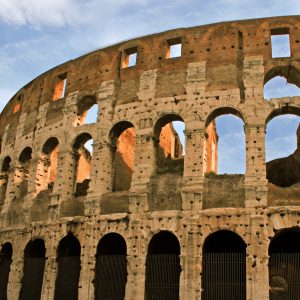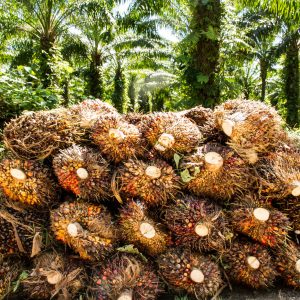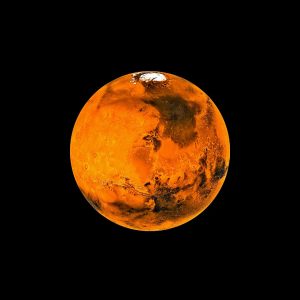Link About It: This Week’s Picks
Self-healing concrete, gemstones on Mars, a viable alternative to palm oil and more

World’s First Vaccine for Honeybees Approved
 The US Department of Agriculture (USDA) has made a significant advancement in the mission to save honeybees and will be using the world’s first vaccine produced to protect the insects from American foulbrood disease. Caused by the bacterium Paenibacillus larvae, it’s a fatal disease for bees that’s easily spread between hives and has been devastating for honeybee colonies. Developed by the US-based biotech company Dalan Animal Health, the vaccine works by “incorporating some of the bacteria into the royal jelly fed by worker bees to the queen, which then ingests it and gains some of the vaccine in the ovaries. The developing bee larvae then have immunity to foulbrood as they hatch.” (Previously, the only solution has been to incinerate affected hives.) The vaccine will be made available to commercial beekeepers first. This is a huge step in saving bees, insects that are essential to “ecosystems and human food security and [the] health” of plants, animals and humans. Read more at The Guardian.
The US Department of Agriculture (USDA) has made a significant advancement in the mission to save honeybees and will be using the world’s first vaccine produced to protect the insects from American foulbrood disease. Caused by the bacterium Paenibacillus larvae, it’s a fatal disease for bees that’s easily spread between hives and has been devastating for honeybee colonies. Developed by the US-based biotech company Dalan Animal Health, the vaccine works by “incorporating some of the bacteria into the royal jelly fed by worker bees to the queen, which then ingests it and gains some of the vaccine in the ovaries. The developing bee larvae then have immunity to foulbrood as they hatch.” (Previously, the only solution has been to incinerate affected hives.) The vaccine will be made available to commercial beekeepers first. This is a huge step in saving bees, insects that are essential to “ecosystems and human food security and [the] health” of plants, animals and humans. Read more at The Guardian.
Image courtesy of Unsplash/Brad Weaver
US Plans to Decarbonize All Domestic Transportation
 The US Departments of Energy, Transportation, Housing and Urban Development, in conjunction with the Environmental Protection Agency, unveiled a first-of-its-kind blueprint outlining how to decarbonize domestic transportation, a plan that aims to cut all of the industry’s greenhouse emissions by 2050. The approach is three-fold: increase the convenience of essential services to improve walkability, improve affordability and efficiency of public transportation, and transition to zero-emission vehicles and sustainable fuels. As domestic transportation makes up a third of US greenhouse emissions and is the second-largest annual household expense in the country, this move is a significant improvement not only for the environment but also for the overall quality and affordability of life. Learn more about the plan at Interesting Engineering.
The US Departments of Energy, Transportation, Housing and Urban Development, in conjunction with the Environmental Protection Agency, unveiled a first-of-its-kind blueprint outlining how to decarbonize domestic transportation, a plan that aims to cut all of the industry’s greenhouse emissions by 2050. The approach is three-fold: increase the convenience of essential services to improve walkability, improve affordability and efficiency of public transportation, and transition to zero-emission vehicles and sustainable fuels. As domestic transportation makes up a third of US greenhouse emissions and is the second-largest annual household expense in the country, this move is a significant improvement not only for the environment but also for the overall quality and affordability of life. Learn more about the plan at Interesting Engineering.
Image courtesy of George Hodan
Vancouver’s Teetering and Twisting Skyscraper
 Vancouver House is a 490-foot skyscraper apartment complex that rests on a narrow triangular base, expanding and twisting as it rises. Designed by Bjarke Ingels Group and managed by real estate developer Westbank, the seemingly precarious building was born from a series of zoning restrictions. It couldn’t be too close to the street, had to be 30 meters away from Granville Bridge and it can’t cast shadows on the nearby park, leaving just a small footprint of usable space. By widening and twisting the structure upward to form an asymmetrical rectangular shape at the top, architects were able to maximize space while following constraints. They used post-tensioned steel cables to anchor the walls to the structure to keep it from leaning and opted for large joints and gaskets between wall panels to give the building more mobility. The stainless steel-clad House took a decade to develop. Read more about the building at Bloomberg.
Vancouver House is a 490-foot skyscraper apartment complex that rests on a narrow triangular base, expanding and twisting as it rises. Designed by Bjarke Ingels Group and managed by real estate developer Westbank, the seemingly precarious building was born from a series of zoning restrictions. It couldn’t be too close to the street, had to be 30 meters away from Granville Bridge and it can’t cast shadows on the nearby park, leaving just a small footprint of usable space. By widening and twisting the structure upward to form an asymmetrical rectangular shape at the top, architects were able to maximize space while following constraints. They used post-tensioned steel cables to anchor the walls to the structure to keep it from leaning and opted for large joints and gaskets between wall panels to give the building more mobility. The stainless steel-clad House took a decade to develop. Read more about the building at Bloomberg.
Image courtesy of Bjarke Ingels Group
How Ancient Roman Concrete Self-Heals
 The durability of ancient Roman structures has long been a mystery to scientists who have sought to determine how early concrete endured for over two millennia. A new study resolves the enigma, focusing on an inclusion (often disregarded as a byproduct) that allows Roman concrete to repair itself: chunks of material referred to as lime clasts. Scientists have found that the clasts are made up of calcium carbonate formed at a high-temperature, most likely by adding a more reactive form of lime called quicklime. This makes the composition brittle, enabling cracks that occur in the concrete to move through the lime clasts easily. Then, when water mixes into these cracks, it forms a solution that hardens back into calcium carbonate, sealing the gap. By re-creating this quicklime concrete and comparing its strength to modern materials, the authors of the study now seek to use their findings to develop stronger commercial concrete. Learn more at New Atlas.
The durability of ancient Roman structures has long been a mystery to scientists who have sought to determine how early concrete endured for over two millennia. A new study resolves the enigma, focusing on an inclusion (often disregarded as a byproduct) that allows Roman concrete to repair itself: chunks of material referred to as lime clasts. Scientists have found that the clasts are made up of calcium carbonate formed at a high-temperature, most likely by adding a more reactive form of lime called quicklime. This makes the composition brittle, enabling cracks that occur in the concrete to move through the lime clasts easily. Then, when water mixes into these cracks, it forms a solution that hardens back into calcium carbonate, sealing the gap. By re-creating this quicklime concrete and comparing its strength to modern materials, the authors of the study now seek to use their findings to develop stronger commercial concrete. Learn more at New Atlas.
Image courtesy of Pxhere
Old Technology Creates a Sustainable Alternative to Palm Oil
 The cultivation of palm oil—a common ingredient in food and beauty products—causes mass deforestation. Around 47% of Malaysia’s forests have been lost, for instance, in order to make way for palm plantations. While finding a replacement for the oil has proven difficult (as it is uniquely composed of almost equal parts saturated and unsaturated fats, a ratio that makes it shelf-stable), scientists have finally devised an alternative—surprisingly, using old technology. During World War I, when food was scarce, German researchers produced high-fat pastes from yeast, growing microbes and microorganisms like algae and feeding them oxygen and sugar to create fermentation. This allowed the microbes to multiply until they reached critical mass, when their oils were extracted. Startups have begun optimizing this technology, including the Netherlands-based company NoPalm (which uses the yeast produced by potato peels and rejected vegetables) and NYC-based company C16 Biosciences (which is slated to launch a hydrating bio oil made by microbial oil in early 2023). Learn more about the vital alternative at National Geographic.
The cultivation of palm oil—a common ingredient in food and beauty products—causes mass deforestation. Around 47% of Malaysia’s forests have been lost, for instance, in order to make way for palm plantations. While finding a replacement for the oil has proven difficult (as it is uniquely composed of almost equal parts saturated and unsaturated fats, a ratio that makes it shelf-stable), scientists have finally devised an alternative—surprisingly, using old technology. During World War I, when food was scarce, German researchers produced high-fat pastes from yeast, growing microbes and microorganisms like algae and feeding them oxygen and sugar to create fermentation. This allowed the microbes to multiply until they reached critical mass, when their oils were extracted. Startups have begun optimizing this technology, including the Netherlands-based company NoPalm (which uses the yeast produced by potato peels and rejected vegetables) and NYC-based company C16 Biosciences (which is slated to launch a hydrating bio oil made by microbial oil in early 2023). Learn more about the vital alternative at National Geographic.
Image courtesy of Juan Carlos Huayllapuma/CIFOR
Arvind Sanjeev’s AI-Powered “Ghostwriter” Typewriter
 Eschewing the typical future-forward design that can leave devices feeling clinical, creative technologist Arvind Sanjeev’s AI-powered Ghostwriter embraces the warm style of a repurposed electric Brother typewriter, clicking keys included. Behind those keys, however, is an AI powered by Arduino, which takes a user’s prompt and “shares it with a raspberry pi which queries the GPT-3 API,” resulting in Ghostwriter typing out a response. The machine can function as a kind of chatbot or an aid to complete a user’s text—be it a poem, letter or beyond. “The calm meditative interface removes all the digital distractions and takes us on an emotional journey through paper and ink. This lets us become more deliberate with our prompts and pulls us to read each word one after the other, helping us understand the nuances profoundly,” Sanjeev tells It’s Nice That. Read more there.
Eschewing the typical future-forward design that can leave devices feeling clinical, creative technologist Arvind Sanjeev’s AI-powered Ghostwriter embraces the warm style of a repurposed electric Brother typewriter, clicking keys included. Behind those keys, however, is an AI powered by Arduino, which takes a user’s prompt and “shares it with a raspberry pi which queries the GPT-3 API,” resulting in Ghostwriter typing out a response. The machine can function as a kind of chatbot or an aid to complete a user’s text—be it a poem, letter or beyond. “The calm meditative interface removes all the digital distractions and takes us on an emotional journey through paper and ink. This lets us become more deliberate with our prompts and pulls us to read each word one after the other, helping us understand the nuances profoundly,” Sanjeev tells It’s Nice That. Read more there.
Image courtesy of Arvind Sanjeev/Ghostwriter
Scientists Discover Gemstones on Mars
 Researchers at Arizona State University working with NASA-affiliated scientists have found that the surface of Mars houses a supply of opal. The semi-precious gemstones form when silica dissolves in water—a process that suggests the region may have once held far more water than we believe. Since water and silica can be separated, the existence of opals also acts as a possible future water source, supporting the dream of one day living on the planet. Discovered in abundance throughout the ancient lake bed known as Gale Crater, these gemstones could also indicate that Mars supports undetected water today. “Given the widespread fracture networks discovered in Gale Crater, it’s reasonable to expect that these potentially habitable subsurface conditions extended to many other regions of Gale Crater as well, and perhaps in other regions of Mars,” says lead author of the study Travis Gabriel. Learn more at MSN.
Researchers at Arizona State University working with NASA-affiliated scientists have found that the surface of Mars houses a supply of opal. The semi-precious gemstones form when silica dissolves in water—a process that suggests the region may have once held far more water than we believe. Since water and silica can be separated, the existence of opals also acts as a possible future water source, supporting the dream of one day living on the planet. Discovered in abundance throughout the ancient lake bed known as Gale Crater, these gemstones could also indicate that Mars supports undetected water today. “Given the widespread fracture networks discovered in Gale Crater, it’s reasonable to expect that these potentially habitable subsurface conditions extended to many other regions of Gale Crater as well, and perhaps in other regions of Mars,” says lead author of the study Travis Gabriel. Learn more at MSN.
Image courtesy of Madhav Fallusion
How Banff Sunshine Ski Resort Farms Snow
 While many ski resorts rely on machines to create artificial snow to pad popular trails and keep areas open for business longer, Sunshine Village Ski Resort in Alberta, Canada (also known as Banff Sunshine) utilizes a clever, sustainable technique called snow farming. The resort sets up miles of fencing above the tree line to capture the vast amounts of snow that the wind blows in. Staff then spreads this reserve snow throughout the areas where it’s needed. Banff Sunshine—one of the earliest pioneers of snow farming and one of the largest operations—is uniquely suited to the technique, as its location has only limited access to water (which is, of course, required to make snow). Farming what is naturally produced allows the resort to eliminate the need for excess water and electricity used by snow machines. Learn more about the technique at Smithsonian Magazine.
While many ski resorts rely on machines to create artificial snow to pad popular trails and keep areas open for business longer, Sunshine Village Ski Resort in Alberta, Canada (also known as Banff Sunshine) utilizes a clever, sustainable technique called snow farming. The resort sets up miles of fencing above the tree line to capture the vast amounts of snow that the wind blows in. Staff then spreads this reserve snow throughout the areas where it’s needed. Banff Sunshine—one of the earliest pioneers of snow farming and one of the largest operations—is uniquely suited to the technique, as its location has only limited access to water (which is, of course, required to make snow). Farming what is naturally produced allows the resort to eliminate the need for excess water and electricity used by snow machines. Learn more about the technique at Smithsonian Magazine.
Image courtesy of Sunshine Village Ski Resort
Link About It is our filtered look at the web, shared daily in Link and on social media, and rounded up every Saturday morning. Hero image courtesy of Arvind Sanjeev/Ghostwriter












